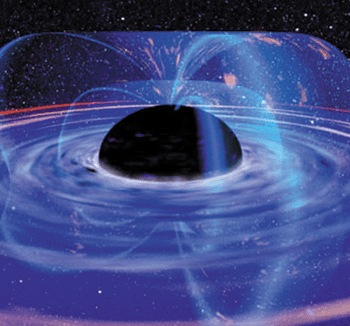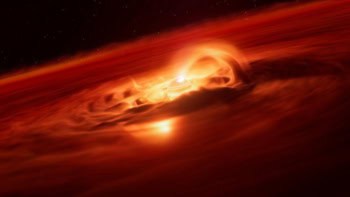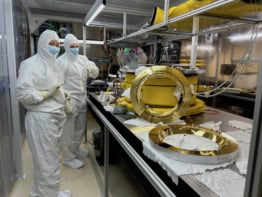Belief in the existence of black holes is the ultimate act of faith for a physicist. First suggested by the English clergyman John Michell in the year 1784, the gravitational pull of a black hole is so strong that nothing - not even light - can escape. Gravity might be the weakest of the fundamental forces but black-hole physics is not for the faint-hearted.

Black holes present obvious problems for would-be observers because they cannot, by definition, be seen with conventional telescopes – although before the end of the decade gravitational-wave detectors should be able to study collisions between black holes (see Physics World December 2001 pp10-11, print version). Until then astronomers can only infer the existence of a black hole from its gravitational influence on other matter, or from the X-rays emitted by gas and dust as they are dragged into the black hole. However, once this material passes through the “event horizon” that surrounds the black hole, we will never see it again – not even with X-ray specs.
Despite these observational problems, most physicists and astronomers believe that black holes do exist. Small black holes a few kilometres across are thought to form when stars weighing more than about two solar masses collapse under the weight of their own gravity, while supermassive black holes weighing millions of solar masses appear to be present at the centre of most galaxies. Moreover, some brave physicists have proposed ways to make black holes – or at least event horizons – in the laboratory (see Artificial black holes on the horizon and Analog models of general relativity).
The basic idea behind these “artificial black holes” is not to compress a large amount of mass into a small volume, but to reduce the speed of light in a moving medium to less than the speed of the medium and so create an event horizon. The parallels with real black holes are not exact but the experiments could shed new light on a variety of phenomena. The first challenge, however, is to get money for the research. One year on from a high-profile meeting on artificial black holes in London, for instance, the UK’s research councils have yet to put any real money behind these ideas.
Black holes are best described by the general theory of relativity. However, general relativity is a classical theory of gravity, and although its predictions have been verified in many experiments, a quantum theory of gravity remains one of the holy grails of physics. One of the first physicists to make real progress in this quest to reconcile general relativity and quantum mechanics was Stephen Hawking.
In 1974 Hawking calculated what would happen if a quantum fluctuation occurred near an event horizon. He concluded that the black hole would radiate, and that the amount of radiation would be inversely proportional to the mass of the black hole. However, black holes tend to be very heavy, so their output of Hawking radiation would be too low to detect experimentally. One intriguing exception could be much smaller primordial black holes created in the big bang: these should radiate observable amounts of gamma rays, but they have not been detected yet. This whole body of work – in which thermodynamic concepts such as temperature and entropy are also associated with the black hole – is Hawking’s major achievement in physics (see From the big bang to the eureka moment).
The detection of Hawking radiation is the ultimate goal of experiments on artificial black holes, although a lot of theoretical and experimental work has to be done first. The successful experiment is likely to involve a flowing Bose-Einstein condensate or a medium in which the speed of light can be reduced to zero (see Physics World February 2001 pp20-21, Black holes go supersonic (summary); September 2001 pp35-40, Taming light with cold atoms). After years of groundwork, physicists have recently made rapid progress in both these fields. Meanwhile, the recent observation of neutrons in discrete quantum states in a gravitational potential shows that quantum gravity effects can be seen in the laboratory (see Neutrons reveal quantum effects of gravity). All that is needed now is an act of faith.



